2016.05.22托福阅读真题回顾与解析
- 格式:docx
- 大小:49.25 KB
- 文档页数:5
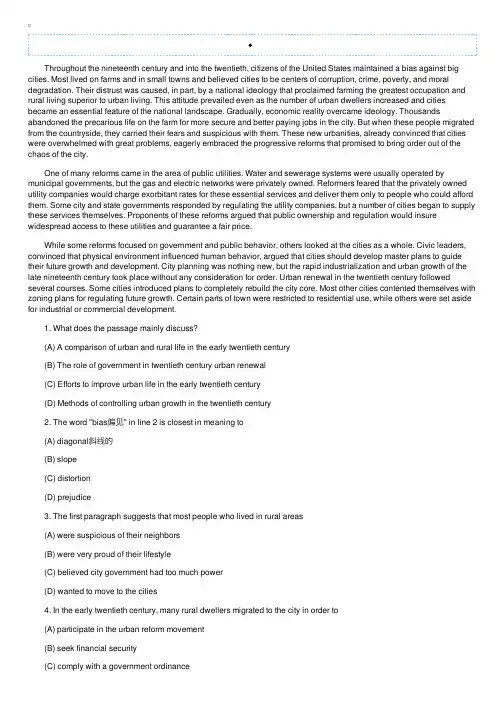
Throughout the nineteenth century and into the twentieth, citizens of the United States maintained a bias against big cities. Most lived on farms and in small towns and believed cities to be centers of corruption, crime, poverty, and moral degradation. Their distrust was caused, in part, by a national ideology that proclaimed farming the greatest occupation and rural living superior to urban living. This attitude prevailed even as the number of urban dwellers increased and cities became an essential feature of the national landscape. Gradually, economic reality overcame ideology. Thousands abandoned the precarious life on the farm for more secure and better paying jobs in the city. But when these people migrated from the countryside, they carried their fears and suspicious with them. These new urbanities, already convinced that cities were overwhelmed with great problems, eagerly embraced the progressive reforms that promised to bring order out of the chaos of the city. One of many reforms came in the area of public utilities. Water and sewerage systems were usually operated by municipal governments, but the gas and electric networks were privately owned. Reformers feared that the privately owned utility companies would charge exorbitant rates for these essential services and deliver them only to people who could afford them. Some city and state governments responded by regulating the utility companies, but a number of cities began to supply these services themselves. Proponents of these reforms argued that public ownership and regulation would insure widespread access to these utilities and guarantee a fair price. While some reforms focused on government and public behavior, others looked at the cities as a whole. Civic leaders, convinced that physical environment influenced human behavior, argued that cities should develop master plans to guide their future growth and development. City planning was nothing new, but the rapid industrialization and urban growth of the late nineteenth century took place without any consideration for order. Urban renewal in the twentieth century followed several courses. Some cities introduced plans to completely rebuild the city core. Most other cities contented themselves with zoning plans for regulating future growth. Certain parts of town were restricted to residential use, while others were set aside for industrial or commercial development. 1. What does the passage mainly discuss? (A) A comparison of urban and rural life in the early twentieth century (B) The role of government in twentieth century urban renewal (C) Efforts to improve urban life in the early twentieth century (D) Methods of controlling urban growth in the twentieth century 2. The word "bias偏见" in line 2 is closest in meaning to (A) diagonal斜线的 (B) slope (C) distortion (D) prejudice 3. The first paragraph suggests that most people who lived in rural areas (A) were suspicious of their neighbors (B) were very proud of their lifestyle (C) believed city government had too much power (D) wanted to move to the cities 4. In the early twentieth century, many rural dwellers migrated to the city in order to (A) participate in the urban reform movement (B) seek financial security (C) comply with a government ordinance (D) avoid crime and corruption 5. The word "embraced拥抱" in line 11 is closest in meaning to (A) suggested (B) overestimated (C) demanded (D) welcomed 6. What concern did reformers have about privately owned utility companies? (A) They feared the services would not be made available to all city dwellers. (B) They believed private ownership would slow economic growth (C) They did not trust the companies to obey the government regulations. (D) They wanted to ensure that the services would be provided to rural areas. 7. The word "exorbitant过⾼的(价钱)" in line 16 is closest in meaning to (A) additional (B) expensive (C) various (D) modified 8. All of the following were the direct result of public utility reforms EXCEPT (A) local governments determined the rates charged by private utility companies (B) some utility companies were owned and operated by local governments (C) the availability of services was regulated by local government (D) private utility companies were required to pay a fee to local governments 9. The word "Proponents⽀持者" in line 18 is closest in meaning to (A) Experts (B) Pioneers (C) Reviewers (D) Supporters 10. Why does the author mention "industrialization" (line 24)? (A) To explain how fast urban growth led to poorly designed cities (B) To emphasize the economic importance of urban areas (C) To suggest that labor disputes had become an urban problem (D) To illustrate the need for construction of new factories CDBBD ABDDA。
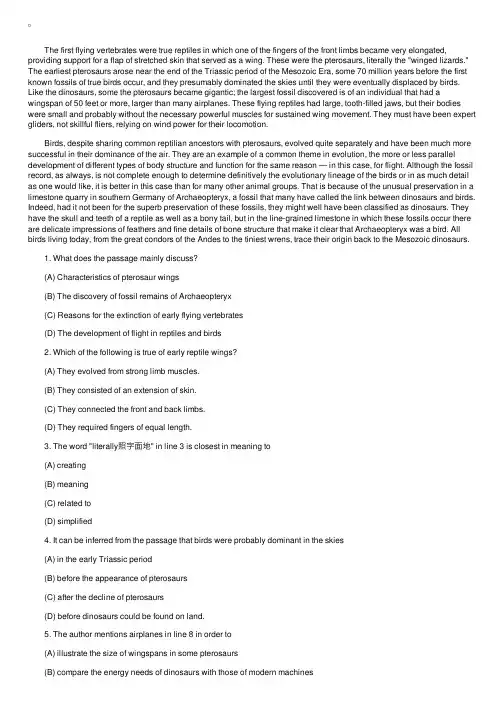
The first flying vertebrates were true reptiles in which one of the fingers of the front limbs became very elongated, providing support for a flap of stretched skin that served as a wing. These were the pterosaurs, literally the "winged lizards." The earliest pterosaurs arose near the end of the Triassic period of the Mesozoic Era, some 70 million years before the first known fossils of true birds occur, and they presumably dominated the skies until they were eventually displaced by birds. Like the dinosaurs, some the pterosaurs became gigantic; the largest fossil discovered is of an individual that had a wingspan of 50 feet or more, larger than many airplanes. These flying reptiles had large, tooth-filled jaws, but their bodies were small and probably without the necessary powerful muscles for sustained wing movement. They must have been expert gliders, not skillful fliers, relying on wind power for their locomotion. Birds, despite sharing common reptilian ancestors with pterosaurs, evolved quite separately and have been much more successful in their dominance of the air. They are an example of a common theme in evolution, the more or less parallel development of different types of body structure and function for the same reason — in this case, for flight. Although the fossil record, as always, is not complete enough to determine definitively the evolutionary lineage of the birds or in as much detail as one would like, it is better in this case than for many other animal groups. That is because of the unusual preservation in a limestone quarry in southern Germany of Archaeopteryx, a fossil that many have called the link between dinosaurs and birds. Indeed, had it not been for the superb preservation of these fossils, they might well have been classified as dinosaurs. They have the skull and teeth of a reptile as well as a bony tail, but in the line-grained limestone in which these fossils occur there are delicate impressions of feathers and fine details of bone structure that make it clear that Archaeopteryx was a bird. All birds living today, from the great condors of the Andes to the tiniest wrens, trace their origin back to the Mesozoic dinosaurs. 1. What does the passage mainly discuss? (A) Characteristics of pterosaur wings (B) The discovery of fossil remains of Archaeopteryx (C) Reasons for the extinction of early flying vertebrates (D) The development of flight in reptiles and birds 2. Which of the following is true of early reptile wings? (A) They evolved from strong limb muscles. (B) They consisted of an extension of skin. (C) They connected the front and back limbs. (D) They required fingers of equal length. 3. The word "literally照字⾯地" in line 3 is closest in meaning to (A) creating (B) meaning (C) related to (D) simplified 4. It can be inferred from the passage that birds were probably dominant in the skies (A) in the early Triassic period (B) before the appearance of pterosaurs (C) after the decline of pterosaurs (D) before dinosaurs could be found on land. 5. The author mentions airplanes in line 8 in order to (A) illustrate the size of wingspans in some pterosaurs (B) compare the energy needs of dinosaurs with those of modern machines (C) demonstrate the differences between mechanized flight and animal flight (D) establish the practical applications of the study of fossils 6. The word "They" in line 10 refers to (A) powerful muscles (B) bodies (C) jaws (D) flying reptiles 7. According to the passage , pterosaurs were probably "not skillful fliers" (lines 10-11) because (A) of their limited wingspan (B) of their disproportionately large bodies (C) they lacked muscles needed for extended flight (D) climate conditions of the time provided insufficient wind power 8. In paragraph 2, the author discusses the development of flight in birds as resulting from (A) a similarity in body structure to pterosaurs (B) an evolution from pterosaurs (C) the dominance of birds and pterosaurs over land animals (D) a separate but parallel development process to that of pterosaurs 9. The word "classified" in line 21 is closest in meaning to (A) perfected (B) replaced (C) categorized (D) protected 10. Which of the following helped researchers determine that Archaeopteryx was not a dinosaur? (A) Its tail (B) Its teeth (C) The shape of its skull (D) Details of its bone structure 11. What is the significance of the discovery that was made in southern Germany? (A) It is thought to demonstrate that birds evolved from dinosaurs. (B) It is proof that the climate and soils of Europe have changed over time. (C) It suggests that dinosaurs were dominant in areas rich in limestone. (D) It supports the theory that Archaeopteryx was a powerful dinosaur. DBBCA DCDCDA。
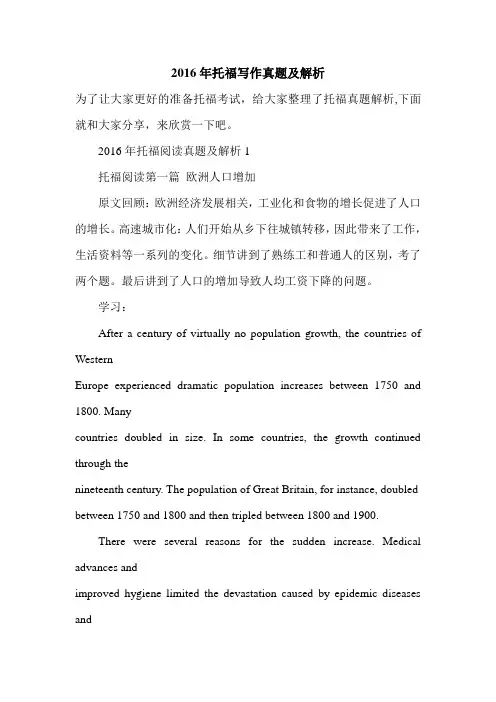
2016年托福写作真题及解析为了让大家更好的准备托福考试,给大家整理了托福真题解析,下面就和大家分享,来欣赏一下吧。
2016年托福阅读真题及解析1托福阅读第一篇欧洲人口增加原文回顾:欧洲经济发展相关,工业化和食物的增长促进了人口的增长。
高速城市化:人们开始从乡下往城镇转移,因此带来了工作,生活资料等一系列的变化。
细节讲到了熟练工和普通人的区别,考了两个题。
最后讲到了人口的增加导致人均工资下降的问题。
学习:After a century of virtually no population growth, the countries of WesternEurope experienced dramatic population increases between 1750 and 1800. Manycountries doubled in size. In some countries, the growth continued through thenineteenth century. The population of Great Britain, for instance, doubled between 1750 and 1800 and then tripled between 1800 and 1900.There were several reasons for the sudden increase. Medical advances andimproved hygiene limited the devastation caused by epidemic diseases andplagues. The introduction of new food crops, most notably the potato, provided abetter diet for the poor and reduced the incidence of famine. The combination ofgreater public order and fewer civil wars meant that life was less hazardous.The net result was a lower death rate and soaring populations.The growing population, with a rising proportion of children to raise andolder people to care for, put increased pressure on every aspect of society. Many peasants were no longer able to provide land for their children, who wereforced to look for other ways to make their living. Small artisans in the citiessuffered similar problems, unable to provide places for their children in theirown workshops.The exact relationship between population growth and industrialization isunclear, though the two are clearly intertwined. (Even countries that were lateto industrialize shared in the general population increase, and its relatedproblems.) What is clear is that the growth in population increased the demandfor both food and manufactured goods and provided an abundance of cheap labor toproduce them.托福阅读第二篇非洲铁技术的发展原文回顾:非洲铁的发展,非洲曾经是被殖民的地方,殖民者大量开采非洲的铁矿资源,并且他们在非洲大规模的用铁矿资源冶炼金属,牵扯到起源,谁把铁的技术引进非洲,以及铁技术之后的发展和改变。
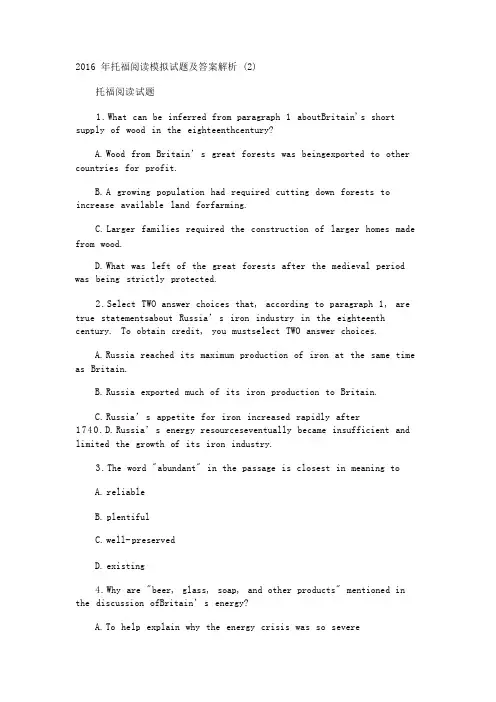
2016 年托福阅读模拟试题及答案解析 (2)托福阅读试题1.What can be inferred from paragraph 1 aboutBritain's short supply of wood in the eighteenthcentury?A.Wood from Britain’s great forests was beingexported to other countries for profit.B.A growing population had required cutting down forests to increase available land forfarming.rger families required the construction of larger homes made from wood.D.What was left of the great forests after the medieval period was being strictly protected.2.Select TWO answer choices that, according to paragraph 1, are true statementsabout Russia’s iron industry in the eighteenth century. To obtain credit, you mustselect TWO answer choices.A.Russia reached its maximum production of iron at the same time as Britain.B.Russia exported much of its iron production to Britain.C.Russia’s appetite for iron increased rapidly after 1740.D.Russia’s energy resourceseventually became insufficient and limited the growth of its iron industry.3.The word "abundant" in the passage is closest in meaning toA.reliableB.plentifulC.well-preservedD.existing4.Why are "beer, glass, soap, and other products" mentioned in the discussion ofBritain’s energy?A.To help explain why the energy crisis was so severeB.To show that despite the energy crisis and as early as 1640, London homes were advancedand well suppliedC.To emphasize that after 1640, British homes required energy for more than heatD.To indicate that coal had been used for the production of certain products before theeighteenth century5.According to paragraph 3, all of the following are ways in which the Savery andNewcomen engines were similar EXCEPT:A.Both became relatively inexpensive after the 1770s.B.Both produced steam by burning coal.C.Both were used to operate pumps.D.Both were very inefficient.6.The word "gifted" in the passage is closest in meaning toA.independentB.talentedC.famousD.ambitious7.According to paragraph 4, what was James Watt’s major achievement?A. He was able to apply his understanding of physics to invent a variety of scientificinstruments and tools for skilled crafts workers.B.He taught university physics courses to outstanding students whose observations led tomany patented inventions.C.He improved the efficiency of Newcomen’s engine by preventing energy from being lost.D.He redesigned Newcomen’s engine so that it no longer needed a separate condenser.8.The word "splendid" in the passage is closest in meaning toA.originalB.necessaryC.magnificentD.popular9.Which of the following is NOT mentioned in paragraph 5 as a development thatgreatly changed the production of iron?A.The use of coke in the smelting of pig ironB.The invention of a furnace that used coke to refine ironC.The discovery of a method for increasing the production of charcoalD.The invention of powerful machinery that could shape, form, and finish iron10.In paragraph 6, why does the author compare British iron production in 1740 withthat of 1844?A.To contrast the amounts of iron needed in Britain in two different centuriesB.To illustrate how easy it was to make money using Cort’s inventionC.To demonstrate the tremendous growth of the iron industry in BritainD.To demonstrate how inexpensive coal had become11.The word "indispensable" in the passage is closest in meaning toA.advantageousB.essentialC.less costlyD.highly stimulating12.According to the passage, which of the following is true about the development ofsteam power?A.The steam engine’s basic technology can be traced back to medieval Britain when steam-powered machinery was being tried in farming activities.B.Although Russia and Britain developed steam-power technology simultaneously,Britain wasfirst to try it in a large-scale industry due to a greater need for iron.C.Steam-power technology was largely the result of improvements developed to increase thesupply of coal as a primary source of energy.D.Adaptations to steam engines required for their use in cotton-spinning mills led to radicaldevelopments in machinery used in the iron industry.13. Look at the four squares [■] that indicate where the following sentence could beadded to the passage.Where would the sentence best fit? Energy had not been aproblem for Britain in the past because it relied on a rich source of energy: its vastforests.By the eighteenth century,Britain was experiencing a severe shortage of energy. ■【A】 Because of the growth of population, most of the great forests of medieval Britain had longago been replaced by fields of grain and hay. ■【B】Wood was in ever-shorter supply, yet itremained tremendously important.■【C】It served as the primary source of heat for allhomes and industries and as a basic raw material.■【D】Processed wood (charcoal) was thefuel that was mixed with iron ore in the blast furnace to produce pig iron (raw iron). The ironindustry’s appetite for wood was enormous, and by 1740 the British iron industry wasstagnating.Vast forests enabled Russia to become the world’s leading producer of iron,much ofwhich was exported to Britain.But Russia’s potential for growth was limited too,and in a fewdecades Russia would reach the barrier of inadequate energy that was already holdingEngland back.14. Directions: An introductory sentence for a brief summary of the passage of thepassage is provided plete the summary by selecting the THREE answerchoices that express the most important ideas in the passage.Some answer choicesdo not belong in the summary because they express ideas that are not presented inthe passage or are minor ideas in the passage. This questions is worth 2 points.By the eighteenth century,Britain was experiencing a severe shortage of energy.A.The development of blast furnaces for the manufacture of pig iron made the Britain lessdependent on wood.B.After the medieval period, both Russia and Britain began to look for alternative sources ofenergy, such as steam power, in order to maintain the growth of their iron industries.C.Two inventors designed the first steam engines in order to overcome the disadvantages ofrelying on horses to power the pumps used in mining coal.D.James Watt was able to improve upon the efficiency of the steam engine and make it usefulto several industries.E.The puddling furnace increased the availability of charcoal to a variety of industries fromcotton to iron production.F.Steam power increased coal production,which in turn allowed extraordinary growth of theiron industry and the British economy.托福阅读答案1.B2.BD3.B4.D5.A6.B7.C8.C9.C10.C11.B12.C13.A14.CDF。
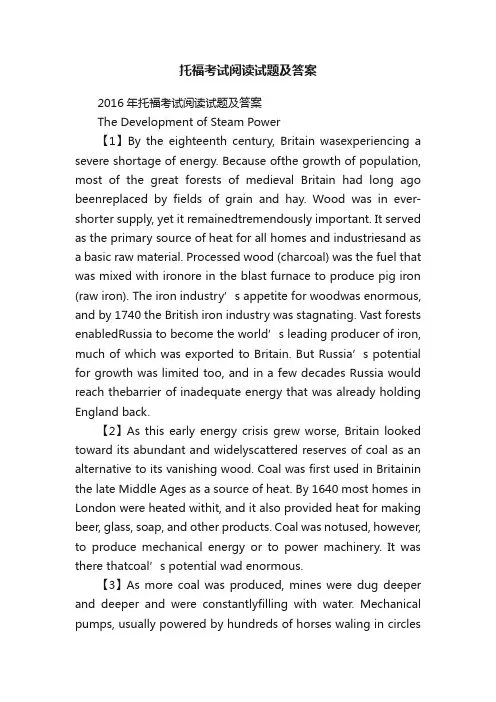
托福考试阅读试题及答案2016年托福考试阅读试题及答案The Development of Steam Power【1】By the eighteenth century, Britain wasexperiencing a severe shortage of energy. Because ofthe growth of population, most of the great forests of medieval Britain had long ago beenreplaced by fields of grain and hay. Wood was in ever-shorter supply, yet it remainedtremendously important. It served as the primary source of heat for all homes and industriesand as a basic raw material. Processed wood (charcoal) was the fuel that was mixed with ironore in the blast furnace to produce pig iron (raw iron). The iron industry’s appetite for woodwas enormous, and by 1740 the British iron industry was stagnating. Vast forests enabledRus sia to become the world’s leading producer of iron, much of which was exported to Britain. But Russia’s potential for growth was limited too, and in a few decades Russia would reach thebarrier of inadequate energy that was already holding England back.【2】As this early energy crisis grew worse, Britain looked toward its abundant and widelyscattered reserves of coal as an alternative to its vanishing wood. Coal was first used in Britainin the late Middle Ages as a source of heat. By 1640 most homes in London were heated withit, and it also provided heat for making beer, glass, soap, and other products. Coal was notused, however, to produce mechanical energy or to power machinery. It was there thatcoal’s potential wad enormous.【3】As more coal was produced, mines were dug deeper and deeper and were constantlyfilling with water. Mechanical pumps, usually powered by hundreds of horses waling in circlesatthe surface, had to be installed Such power was expensive and bothersome. In an attempt toovercome these disadvantages, Thomas Savery in 1698 and Thomas Newcomen in 1705 invented the first primitive steam engines. Both engines were extremely inefficient. Bothburned coal to produce steam, which was then used to operate a pump. However, by theearly 1770s, many of the Savery engines and hundreds of the Newcomen engines wereoperating successfully, though inefficiently, in English and Scottish mines.【4】In the early 1760s, a gifted young Scot named James Watt was drawn to a critical studyof the steam engine. Watt was employed at the time by the University of Glasgow as a skilledcrafts worker making scientific instruments. In 1763: Watt was called on to repair a Newcomenengine being used in a physics course. After a series of observations, Watt saw that theNewcomen’s wast e of energy could be reduced by adding a separate condenser. This splendidinvention, patented in 1769, greatly increased the efficiency of the steam engine. The steamengine of Watt and his followers was the technological advance that gave people, at least for awhile, unlimited power and allowed the invention and use of all kinds of power equipment.【5】The steam engine was quickly put to use in several industries in Britain. It drained minesand made possible the production of ever more coal to feed steam engines elsewhere. Thesteam power plant began to replace waterpower in the cotton-spinning mills as well as otherindustries during the 1780s, contributing to a phenomenal rise in industrialization. TheBritish iron industry was radically transformed. The use of powerful, steam-driven bellows inblast furnaces helped iron makers switchover rapidly from limited charcoal to unlimited coke(which is made from coal) in the smelting of pig iron (the process of refining impure iron) after1770 in the 1780s, Henry Cort developed the puddling furnace, which allowed pig iron to berefined in turn with coke. Cort also developed heavy-duty, steam-powered rolling mills, whichwere capable of producing finished iron in every shape and form.【6】The economic consequence of these technical innovations in steam power was a greatboom in the British iron industry. In 1740 annual British iron production was only 17:000 tons, but by 1844: with the spread of coke smelting and the impact of Cort’s inventions, it hadincreased to 3,000:000 to ns. This was a truly amazing expansion. Once scarce and expensive, iron became cheap, basic, and indispensable to the economy.试题1.What can be inferred from paragraph 1 aboutBritain's short supply of wood in the eighteenthcentury?A.Wood from Britain’s gr eat forests was beingexported to other countries for profit.B.A growing population had required cutting down forests to increase available land forfarming.rger families required the construction of larger homes made from wood.D.What was left of the great forests after the medieval period was being strictly protected.2.Select TWO answer choices that, according to paragraph 1, are true statementsabout Russia’s iron industry in the eighteenth century. To obtain credit, you mustselect TWO answer choices.A.Russia reached its maximum production of iron at the sametime as Britain.B.Russia exported much of its iron production to Britain.C.Russia’s appetite for iron increased rapidly after 1740.D.Russia’s energy resourceseventually became insufficient and limited the growth of its iron industry.3.The word "abundant" in the passage is closest in meaning toA.reliableB.plentifulC.well-preservedD.existing4.Why are "beer, glass, soap, and other products" mentioned in the discussion ofBritain’s energy?A.To help explain why the energy crisis was so severeB.To show that despite the energy crisis and as early as 1640, London homes were advancedand well suppliedC.To emphasize that after 1640, British homes required energy for more than heatD.To indicate that coal had been used for the production of certain products before theeighteenth century5.According to paragraph 3, all of the following are ways in which the Savery andNewcomen engines were similar EXCEPT:A.Both became relatively inexpensive after the 1770s.B.Both produced steam by burning coal.C.Both were used to operate pumps.D.Both were very inefficient.6.The word "gifted" in the passage is closest in meaning toA.independentB.talentedC.famousD.ambitious7.According to paragraph 4, what was Jam es Watt’s major achievement?A. He was able to apply his understanding of physics to invent a variety of scientificinstruments and tools for skilled crafts workers.B.He taught university physics courses to outstanding students whose observations led tomany patented inventions.C.He improved the efficiency of Newcomen’s engine by preventing energy from being lost.D.He redesigned Newcomen’s engine so that it no longer needed a separate condenser.8.The word "splendid" in the passage is closest in meaning toA.originalB.necessaryC.magnificentD.popular9.Which of the following is NOT mentioned in paragraph 5 as a development thatgreatly changed the production of iron?A.The use of coke in the smelting of pig ironB.The invention of a furnace that used coke to refine ironC.The discovery of a method for increasing the production of charcoalD.The invention of powerful machinery that could shape, form, and finish iron10.In paragraph 6, why does the author compare British iron production in 1740 withthat of 1844?A.To contrast the amounts of iron needed in Britain in two different centuriesB.To illustrate how easy it was to make money using Cort’s inventionC.To demonstrate the tremendous growth of the iron industry in BritainD.To demonstrate how inexpensive coal had become11.The word "indispensable" in the passage is closest in meaning toA.advantageousB.essentialC.less costlyD.highly stimulating12.According to the passage, which of the following is true about the development ofsteam power?A.The steam e ngine’s basic technology can be traced back to medieval Britain when steam-powered machinery was being tried in farming activities.B.Although Russia and Britain developed steam-power technology simultaneously, Britain wasfirst to try it in a large-scale industry due to a greater need for iron.C.Steam-power technology was largely the result of improvements developed to increase thesupply of coal as a primary source of energy.D.Adaptations to steam engines required for their use in cotton-spinning mills led to radicaldevelopments in machinery used in the iron industry.13. Look at the four squares [■] that indicate where the following sentence could beadded to the passage. Where would the sentence best fit? Energy had not been aproblem for Britain in the past because it relied on a rich source of energy: its vastforests.By the eighteenth century, Britain was experiencing a severe shortage of energy. ■【A】 Because of the growth of population, most of the great forests of medieval Britain had longago been repl aced by fields of grain and hay. ■【B】Wood was in ever-shorter supply, yet itremained tremendously important. ■【C】It served as the primary source of heat for allhomes and industries and as a basic raw material. ■【D】Processed wood (charcoal) was thefuel that was mixed with iron ore in the blast furnace to produce pig iron (raw iron). The ironindustry’s appetite for wood was enormous, and by 1740 the British iron industry wasstagnating. Vast forests enabled Russia to become the world’s leading producer of iron, much ofwhich was exported to Britain. But Russia’s potential for growth was limited too, and in a fewdecades Russia would reach the barrier of inadequate energy that was already holdingEngland back.14. Directions: An introductory sentence for a brief summary of the passage of thepassage is provided below. Complete the summary by selecting the THREE answerchoices that express the most important ideas in the passage. Some answer choicesdo not belong in the summary because they express ideas that are not presented inthe passage or are minor ideas in the passage. This questions is worth 2 points.By the eighteenth century, Britain was experiencing a severe shortage of energy.A.The development of blast furnaces for the manufacture of pig iron made the Britain lessdependent on wood.B.After the medieval period, both Russia and Britain began to look for alternative sources ofenergy, such as steam power, in order to maintain the growth of their iron industries.C.Two inventors designed the first steam engines in order toovercome the disadvantages ofrelying on horses to power the pumps used in mining coal.D.James Watt was able to improve upon the efficiency of the steam engine and make it usefulto several industries.E.The puddling furnace increased the availability of charcoal to a variety of industries fromcotton to iron production.F.Steam power increased coal production, which in turn allowed extraordinary growth of theiron industry and the British economy.参考答案1.B2.BD3.B4.D5.A6.B7.C8.C9.C 10.C 11.B 12.C 13.A 14.CDF。
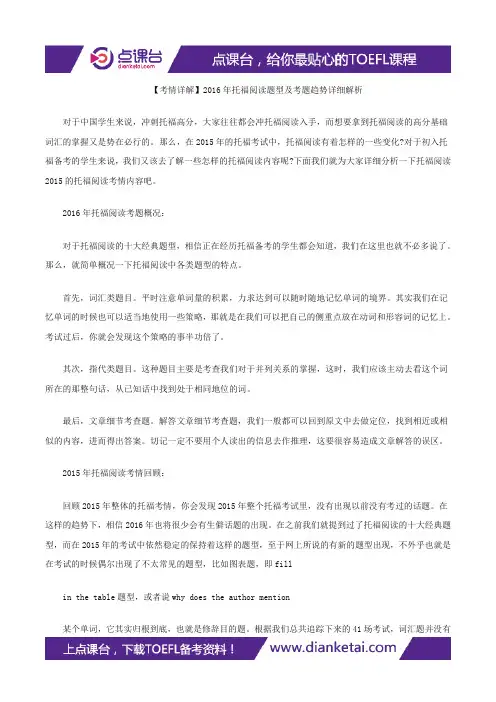
【考情详解】2016年托福阅读题型及考题趋势详细解析对于中国学生来说,冲刺托福高分,大家往往都会冲托福阅读入手,而想要拿到托福阅读的高分基础词汇的掌握又是势在必行的。
那么,在2015年的托福考试中,托福阅读有着怎样的一些变化?对于初入托福备考的学生来说,我们又该去了解一些怎样的托福阅读内容呢?下面我们就为大家详细分析一下托福阅读2015的托福阅读考情内容吧。
2016年托福阅读考题概况:对于托福阅读的十大经典题型,相信正在经历托福备考的学生都会知道,我们在这里也就不必多说了。
那么,就简单概况一下托福阅读中各类题型的特点。
首先,词汇类题目。
平时注意单词量的积累,力求达到可以随时随地记忆单词的境界。
其实我们在记忆单词的时候也可以适当地使用一些策略,那就是在我们可以把自己的侧重点放在动词和形容词的记忆上。
考试过后,你就会发现这个策略的事半功倍了。
其次,指代类题目。
这种题目主要是考查我们对于并列关系的掌握,这时,我们应该主动去看这个词所在的那整句话,从已知话中找到处于相同地位的词。
最后,文章细节考查题。
解答文章细节考查题,我们一般都可以回到原文中去做定位,找到相近或相似的内容,进而得出答案。
切记一定不要用个人读出的信息去作推理,这要很容易造成文章解答的误区。
2015年托福阅读考情回顾:回顾2015年整体的托福考情,你会发现2015年整个托福考试里,没有出现以前没有考过的话题。
在这样的趋势下,相信2016年也将很少会有生僻话题的出现。
在之前我们就提到过了托福阅读的十大经典题型,而在2015年的考试中依然稳定的保持着这样的题型,至于网上所说的有新的题型出现,不外乎也就是在考试的时候偶尔出现了不太常见的题型,比如图表题,即fillin the table题型,或者说why does the author mention某个单词,它其实归根到底,也就是修辞目的题。
根据我们总共追踪下来的41场考试,词汇题并没有出现新的生僻的单词,依然延续了之前所考过的词汇题的套路。
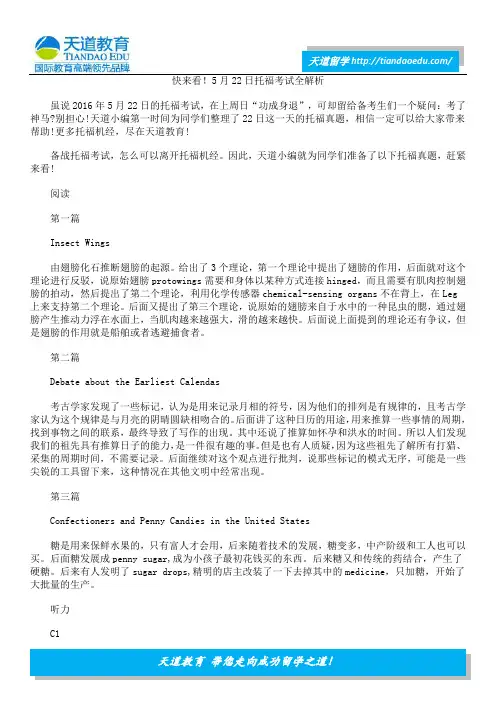
快来看!5月22日托福考试全解析虽说2016年5月22日的托福考试,在上周日“功成身退”,可却留给备考生们一个疑问:考了神马?别担心!天道小编第一时间为同学们整理了22日这一天的托福真题,相信一定可以给大家带来帮助!更多托福机经,尽在天道教育!备战托福考试,怎么可以离开托福机经。
因此,天道小编就为同学们准备了以下托福真题,赶紧来看!阅读第一篇Insect Wings由翅膀化石推断翅膀的起源。
给出了3个理论,第一个理论中提出了翅膀的作用,后面就对这个理论进行反驳,说原始翅膀protowings需要和身体以某种方式连接hinged,而且需要有肌肉控制翅膀的拍动,然后提出了第二个理论,利用化学传感器chemical-sensing organs不在背上,在Leg上来支持第二个理论。
后面又提出了第三个理论,说原始的翅膀来自于水中的一种昆虫的腮,通过翅膀产生推动力浮在水面上,当肌肉越来越强大,滑的越来越快。
后面说上面提到的理论还有争议,但是翅膀的作用就是船舶或者逃避捕食者。
第二篇Debate about the Earliest Calendas考古学家发现了一些标记,认为是用来记录月相的符号,因为他们的排列是有规律的,且考古学家认为这个规律是与月亮的阴晴圆缺相吻合的。
后面讲了这种日历的用途,用来推算一些事情的周期,找到事物之间的联系,最终导致了写作的出现。
其中还说了推算如怀孕和洪水的时间。
所以人们发现我们的祖先具有推算日子的能力,是一件很有趣的事。
但是也有人质疑,因为这些祖先了解所有打猎、采集的周期时间,不需要记录。
后面继续对这个观点进行批判,说那些标记的模式无序,可能是一些尖锐的工具留下来,这种情况在其他文明中经常出现。
第三篇Confectioners and Penny Candies in the United States糖是用来保鲜水果的,只有富人才会用,后来随着技术的发展,糖变多,中产阶级和工人也可以买。
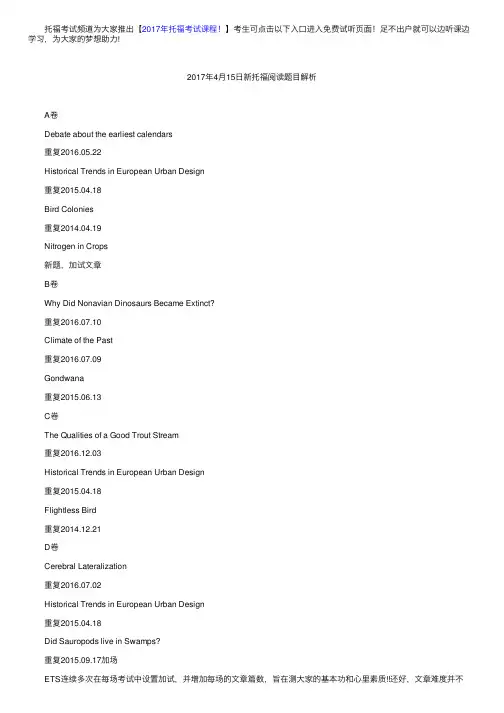
托福考试频道为⼤家推出【2017年托福考试课程!】考⽣可点击以下⼊⼝进⼊免费试听页⾯!⾜不出户就可以边听课边学习,为⼤家的梦想助⼒!2017年4⽉15⽇新托福阅读题⽬解析 A卷 Debate about the earliest calendars 重复2016.05.22 Historical Trends in European Urban Design 重复2015.04.18 Bird Colonies 重复2014.04.19 Nitrogen in Crops 新题,加试⽂章 B卷 Why Did Nonavian Dinosaurs Became Extinct? 重复2016.07.10 Climate of the Past 重复2016.07.09 Gondwana 重复2015.06.13 C卷 The Qualities of a Good Trout Stream 重复2016.12.03 Historical Trends in European Urban Design 重复2015.04.18 Flightless Bird 重复2014.12.21 D卷 Cerebral Lateralization 重复2016.07.02 Historical Trends in European Urban Design 重复2015.04.18 Did Sauropods live in Swamps? 重复2015.09.17加场 ETS连续多次在每场考试中设置加试,并增加每场的⽂章篇数,旨在测⼤家的基本功和⼼⾥素质!!还好,⽂章难度并不⼤,皆为之前考过的⽂章和TPO中出现的相关话题,切记不要慌张! 新托福阅读考情回忆版本⼀: Passage1: nitrogen。
氮对于植物的重要性,氮可以由打雷和被微⽣物分解⽽合成,种了庄稼后氮会变少,氮有⼈为的添加⽅式,⽐如种⾖类植物,氮肥,氮的新应⽤导致英国⼯业⾰命对⽐⾮洲不断的换耕地 Passage2: early calendar。
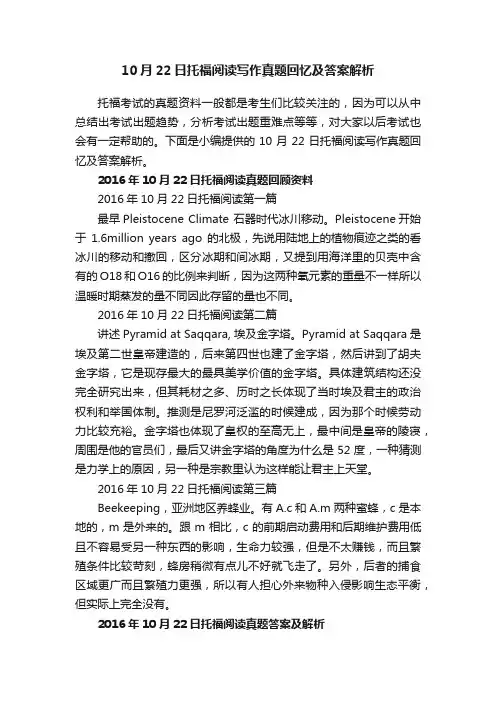
10月22日托福阅读写作真题回忆及答案解析托福考试的真题资料一般都是考生们比较关注的,因为可以从中总结出考试出题趋势,分析考试出题重难点等等,对大家以后考试也会有一定帮助的。
下面是小编提供的10月22日托福阅读写作真题回忆及答案解析。
2016年10月22日托福阅读真题回顾资料2016年10月22日托福阅读第一篇最早Pleistocene Climate 石器时代冰川移动。
Pleistocene开始于1.6million years ago的北极,先说用陆地上的植物痕迹之类的看冰川的移动和撤回,区分冰期和间冰期,又提到用海洋里的贝壳中含有的O18和O16的比例来判断,因为这两种氧元素的重量不一样所以温暖时期蒸发的量不同因此存留的量也不同。
2016年10月22日托福阅读第二篇讲述Pyramid at Saqqara, 埃及金字塔。
Pyramid at Saqqara是埃及第二世皇帝建造的,后来第四世也建了金字塔,然后讲到了胡夫金字塔,它是现存最大的最具美学价值的金字塔。
具体建筑结构还没完全研究出来,但其耗材之多、历时之长体现了当时埃及君主的政治权利和举国体制。
推测是尼罗河泛滥的时候建成,因为那个时候劳动力比较充裕。
金字塔也体现了皇权的至高无上,最中间是皇帝的陵寝,周围是他的官员们,最后又讲金字塔的角度为什么是52度,一种猜测是力学上的原因,另一种是宗教里认为这样能让君主上天堂。
2016年10月22日托福阅读第三篇Beekeeping,亚洲地区养蜂业。
有A.c和A.m两种蜜蜂,c是本地的,m是外来的。
跟m相比,c的前期启动费用和后期维护费用低且不容易受另一种东西的影响,生命力较强,但是不太赚钱,而且繁殖条件比较苛刻,蜂房稍微有点儿不好就飞走了。
另外,后者的捕食区域更广而且繁殖力更强,所以有人担心外来物种入侵影响生态平衡,但实际上完全没有。
2016年10月22日托福阅读真题答案及解析2016年10月22日托福阅读词汇题:deterioration = worsen conditionend = purposesimultaneously = at the same timetrigger = startvocation = occupationjustification = good reasonconversely =in contrastuniformally = consistentlyconstrained = forcedinnumerable = countless2016年10月22日托福阅读第一篇题材划分:地质环境类主要内容:最早Pleistocene Climate 石器时代冰川移动。
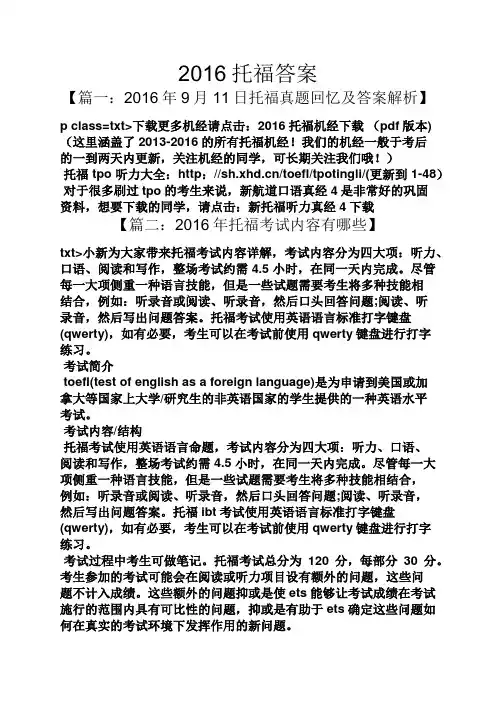
2016托福答案【篇一:2016年9月11日托福真题回忆及答案解析】p class=txt>下载更多机经请点击:2016托福机经下载(pdf版本)(这里涵盖了2013-2016的所有托福机经!我们的机经一般于考后的一到两天内更新,关注机经的同学,可长期关注我们哦!)托福tpo听力大全:http:///toefl/tpotingli/(更新到1-48)对于很多刷过tpo的考生来说,新航道口语真经4是非常好的巩固资料,想要下载的同学,请点击:新托福听力真经4下载【篇二:2016年托福考试内容有哪些】txt>小新为大家带来托福考试内容详解,考试内容分为四大项:听力、口语、阅读和写作,整场考试约需 4.5 小时,在同一天内完成。
尽管每一大项侧重一种语言技能,但是一些试题需要考生将多种技能相结合,例如:听录音或阅读、听录音,然后口头回答问题;阅读、听录音,然后写出问题答案。
托福考试使用英语语言标准打字键盘(qwerty),如有必要,考生可以在考试前使用qwerty键盘进行打字练习。
考试简介toefl(test of english as a foreign language)是为申请到美国或加拿大等国家上大学/研究生的非英语国家的学生提供的一种英语水平考试。
考试内容/结构托福考试使用英语语言命题,考试内容分为四大项:听力、口语、阅读和写作,整场考试约需 4.5 小时,在同一天内完成。
尽管每一大项侧重一种语言技能,但是一些试题需要考生将多种技能相结合,例如:听录音或阅读、听录音,然后口头回答问题;阅读、听录音,然后写出问题答案。
托福ibt考试使用英语语言标准打字键盘(qwerty),如有必要,考生可以在考试前使用qwerty键盘进行打字练习。
考试过程中考生可做笔记。
托福考试总分为120分,每部分30分。
考生参加的考试可能会在阅读或听力项目设有额外的问题,这些问题不计入成绩。
这些额外的问题抑或是使ets能够让考试成绩在考试施行的范围内具有可比性的问题,抑或是有助于ets确定这些问题如何在真实的考试环境下发挥作用的新问题。
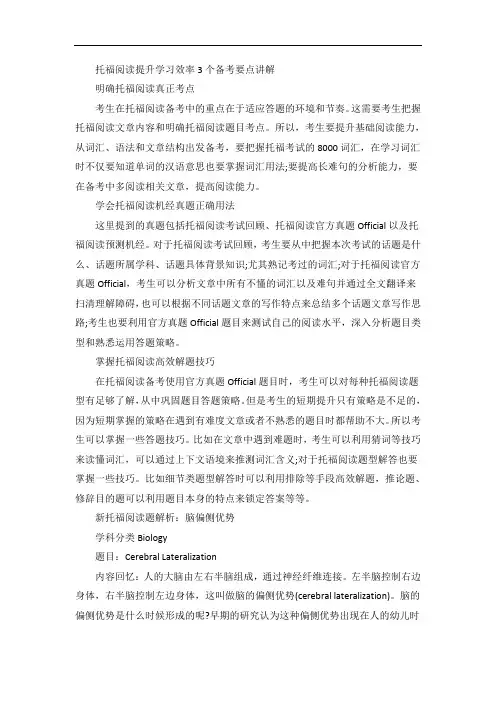
托福阅读提升学习效率3个备考要点讲解明确托福阅读真正考点考生在托福阅读备考中的重点在于适应答题的环境和节奏。
这需要考生把握托福阅读文章内容和明确托福阅读题目考点。
所以,考生要提升基础阅读能力,从词汇、语法和文章结构出发备考,要把握托福考试的8000词汇,在学习词汇时不仅要知道单词的汉语意思也要掌握词汇用法;要提高长难句的分析能力,要在备考中多阅读相关文章,提高阅读能力。
学会托福阅读机经真题正确用法这里提到的真题包括托福阅读考试回顾、托福阅读官方真题Official以及托福阅读预测机经。
对于托福阅读考试回顾,考生要从中把握本次考试的话题是什么、话题所属学科、话题具体背景知识;尤其熟记考过的词汇;对于托福阅读官方真题Official,考生可以分析文章中所有不懂的词汇以及难句并通过全文翻译来扫清理解障碍,也可以根据不同话题文章的写作特点来总结多个话题文章写作思路;考生也要利用官方真题Official题目来测试自己的阅读水平,深入分析题目类型和熟悉运用答题策略。
掌握托福阅读高效解题技巧在托福阅读备考使用官方真题Official题目时,考生可以对每种托福阅读题型有足够了解,从中巩固题目答题策略。
但是考生的短期提升只有策略是不足的,因为短期掌握的策略在遇到有难度文章或者不熟悉的题目时都帮助不大。
所以考生可以掌握一些答题技巧。
比如在文章中遇到难题时,考生可以利用猜词等技巧来读懂词汇,可以通过上下文语境来推测词汇含义;对于托福阅读题型解答也要掌握一些技巧。
比如细节类题型解答时可以利用排除等手段高效解题,推论题、修辞目的题可以利用题目本身的特点来锁定答案等等。
新托福阅读题解析:脑偏侧优势学科分类Biology题目:Cerebral Lateralization内容回忆:人的大脑由左右半脑组成,通过神经纤维连接。
左半脑控制右边身体,右半脑控制左边身体,这叫做脑的偏侧优势(cerebral lateralization)。
Although only 1 person in 20 in the Colonial period lived in a city, the cities had a disproportionate influence on the development of North America. They were at the cutting edge of social change. It was in the cities that the elements that can be associated with modern capitalism first appeared — the use of money and commercial paper in place of barter, open competition in place of social deference and hierarchy, with an attendant rise in social disorder, and the appearance of factories using coat or water power in place of independent craftspeople working with hand tools. "The cities predicted the future," wrote historian Gary. B. Nash, "even though they were but overgrown villages compared to the great urban centers of Europe, the Middle East and China." Except for Boston, whose population stabilized at about 16,000 in 1760, cities grew by exponential leaps through the eighteenth century. In the fifteen years prior to the outbreak of the War for independence in 1775, more than 200,000 immigrants arrived on North American shores. This meant that a population the size of Boston was arriving every year, and most of it flowed into the port cities in the Northeast. Philadelphia's population nearly doubted in those years, reaching about 30,000 in 1774, New York grew at almost the same rate, reaching about 25,000 by 1775. The quality of the hinterland dictated the pace of growth of the cities. The land surrounding Boston had always been poor farm country, and by the mid-eighteenth century it was virtually stripped of its timber. The available farmland was occupied, there was little in the region beyond the city to attract immigrants. New York and Philadelphia, by contrast, served a rich and fertile hinterland laced with navigable watercourses. Scots, Irish, and Germans landed in these cities and followed the rivers inland. The regions around the cities of New York and Philadelphia became the breadbaskets of North America, sending grain not only to other colonies but also to England and southern Europe, where crippling droughts in the late 1760's created a whole new market. 1. Which of the following aspects of North America in the eighteenth century does the passage mainly discuss? (A) The effects of war on the growth of cities (B) The growth and influence of cities (C) The decline of farming in areas surrounding cities (D) The causes of immigration to cities 2. Why does the author say that "the cities had a disproportionate influence on the development of North America" (lines 1-2)? (A) The influence of the cities was mostly negative (B) The populations of the cities were small, but their influence was great. (C) The cities were growing at a great rate. (D) Most people pretended to live in cities 3. The phrase "in place of " in lines 4-5 is closest in meaning to (A) connected to (B) in addition to (C) because of (D) instead of 4. The word "attendant伴随的" in line 6 is closest in meaning to (A) avoidable (B) accompanying (C) unwelcome (D) unexpected 5. Which of the following is mentioned as an element of modern capitalism? (B) Social deference (C) Social hierarchy (D) Independent craftspeople 6. It can be inferred that in comparison with North American cities, cities in Europe, the Middle East, and China had (A) large populations (B) little independence (C) frequent social disorder (D) few power sources 7. The phrase "exponential迅猛的 leaps" in line 12 is closest in meaning to (A) long wars (B) new laws (C) rapid increases (D) exciting changes 8. The word "it" in line 15 refers to (A) population (B) size (C) Boston (D) Year 9. How many immigrants arrived in North America between 1760 and 1775? (A) About 16,000 (B) About 25,000 (C) About 30,000 (D) More than 200,000 10. The word "dictated决定" in line 18 is closest in meaning to (A) spoiled (B) reduced (C) determined (D) divided 11. The word "virtually⼏乎" in line 20 is closest in meaning to (A) usually (B) hardly (C) very quickly (D) almost completely 12. The region surrounding New York and Philadelphia is contrasted with the region surrounding Boston in terms of (B) origin of immigrants (C) opportunities for fishing (D) type of grain grown 13. Why does the author describe the regions around the cities of New York and Philadelphia as "breadbaskets"? (A) They produced grain especially for making bread. (B) They stored large quantities of grain during periods of drought (C) They supplied grain to other parts of North America and other countries. (D) They consumed more grain than all the other regions of North America. BBDBA ACADC DAC。
往年托福阅读真题及答案托福(TOEFL)历年真题的重要性不言而喻,这是目前托福考试出题思路的唯一参考资料,因此现今每场托福考试中都会出现大量的旧题,那么能拿到最高效的真题资料就尤为关键了。
下面给大家带来托福阅读真题,希望对你们有所帮助。
往年托福阅读真题及答案In discussing the growth of cities in the United States in the nineteenth century, one cannot really use the term “urban planning,” as it suggests modern concerns for spatial and service organization which, in most instances, did not exist before the planning revolution called the City Beautiful Movement that began in the 1890s.While there certainly were urban areas that were “planned” in the comprehensive contemporary sense of the word before that date, most notably Washington, D.C., these were the excepti on. Most “planned” in the nineteenth century was limited to areas much smaller than a city and was closely associated with developers trying to make a profit from a piece of land. Even when these small-scale plans were well designed, the developers made only those improvements that were absolutely necessary to attract the wealthy segment of the market. Indeed, it was the absence of true urban planning that allowed other factors to play such an important role in shaping the nineteenth-century American city.1. Which of the sentences below best expresses the essential information in the highlighted sentence in the passage? Incorrect choices change the meaning in important ways or leave out essential information.A.Understanding the growth of cities in nineteenth-century America requires recognizing how the City Beautiful Movementof the 1890s changed “urban planning.”B.For the most part, there was no “urban planning,” as that term is understood today, before the beginning of the City Beautiful Movement in the 1890s.C.oncerns for spatial and service organization had little impact on the growth of cities before the 1890s when the City Beautiful Movement began.D.The growth of cities in nineteenth-century America resulted in the creation of the City Beautiful Movement in the 1890s and the rise of the term “urban planning.”首先我们先明确题目的要求,其实题目中一共应该是3个核心重点要求:(1)best expresses the essential information in the highlighted sentence in the passage(2)Incorrect choices change the meaning in important ways(3)or leave out essential information.通过对题目的分析我们不难发现,essential这个单词出现了2次,换言之,题目要求大家做的是“找出句子的核心含义”,那么什么算是“核心含义”呢?要明白这个问题就要深刻理解一个概念:英语句内逻辑结构比如although A, B 中 AB两部分为让步转折关系,核心点是转折后的B句,because A, B中AB两部分为因果关系,核心点是结论B句。
托福阅读原⽂ Protection of Plants by Insects 【1】Many plants - one or more species of at least68 different families - can secrete nectar even whenthey have no blossoms, because they bear extrafloral nectaries (structures that producenectar) on stems, leaves, leaf stems, or other structures.These plants usually occur where antsare abundant, most in the tropics but some in temperate areas. Among those of northeasternNorth America are various plums, cherries, roses, hawthorns, poplars, and oaks. Like floralnectar, extrafloral nectar consists mainly of water with a high content of dissolved sugars and, in some plants, small amounts of amino acids. The extrafloral nectaries of some plants areknown to attract ants and other insects, but the evolutionary history of most plants with thesenectaries is unknown. Nevertheless, most ecologists believe that all extrafloral nectaries attractinsects that will defend the plant. 【2】Ants are portably the most frequent and certainly the most persistent defenders ofplants. Since the highly active worker ants require a great deal of energy, plants exploit thisneed by providing extrafloral nectar that supplies ants with abundant energy. To return thisfavor, ants guard the nectaries, driving away or killing intruding insects that might competewith ants for nectar. Many of these intruders are herbivorous and would eat the leaves of theplants. 【3】Biologists once thought that secretion of extrafloral nectar has some purely internalphysiological function, and that ants provide no benefit whatsoever to the plants that secreteit. This view and the opposing “protectionist” hypothesis that ants defend plants had beendisputed for over a hundred years when, in 1910, a skeptical William Morton Wheelercommented on the controversy. He called for proof of the protectionist view: that visitations ofthe ants confer protection on the plants and that in the absence of the insects a much greaternumber would perish or fail to produce flowers or seeds than when the insects are present. That we now have an abundance of the proof that was called for was established whenBarbara Bentley reviewed the relevant evidence in 1977, and since then many moreobservations and experiments have provided still further proof that ants benefit plants. 【4】One example shows how ants attracted to extrafloral nectaries protect morning gloriesagainst attacking insects. The principal insect enemies of the North American morning gloryfeed mainly on its flowers or fruits rather than its leaves. Grasshoppers feeding on flowersindirectly block pollination and the production of seeds by destroying the corolla or thestigma, which receives the pollen grains and on which the pollen germinates. Without theircolorful corolla, flowers do not attract pollinators and are not fertilized. An adult grasshoppercan consume a large corolla, about 2.5 inches long, in an hour. Caterpillars and seed beetlesaffect seed production directly. Caterpillars devour the ovaries, where the seeds are produced, and seed beetle larvae eat seeds as they burrow in developing fruits. 【5】Extrafloral nectaries at the base of each sepal attract several kinds of insects, but 96 percent of them are ants, several different species of them. When buds are still small, lessthan a quarter of an inch long, the sepal nectaries are already present and producing nectar. They continue to do so as the flower develops and while the fruit matures. Observations leavelittle doubt that ants protect morning glory flowers and fruits from the combined enemy forceof grasshoppers, caterpillars, and seed beetles. Bentley compares the seed production of sixplants that grew where there were no ants with that of seventeen plants that were occupied byants. Unprotected plants bore only 45 seeds per plant, but plants occupied by ants bore 211 seeds per plant. Although ants are not big enough to kill or seriously injure grasshoppers, theydrive them away by nipping at their feet. Seed beetles are more vulnerable because they aremuch smaller than grasshoppers. The ants prey on the adult beetles, disturb females astheylay their eggs on developing fruits, and eat many of the eggs they do manage to lay. 托福阅读试题 1.According to paragraph 1,floral nectar andextrafloral nectar are alike in that A.they are likely to be produced by the same plants. B.they basically consist of the same chemicalcomponents. C.they attract only insects that will defend the plant. D.they are produced by the same parts of the plant. 2.To say that ants are "persistent" defenders of plants means that A.they defend plants against a wide variety of threats. B.they continue to defend plants for as long as the plants are threatened. C.they are successful defenders of plants. D.they are easily observable defenders of plants. 3.What can be inferred from paragraph 2 about the ants that are attracted to theextrafloral nectaries? A.They do not eat the leaves of the plants that produce extrafloral nectar. B.They live almost entirely on extrafloral nectar. C.They spend most of their energy guarding extrafloral nectaries. D.They frequently fight among themselves over extrafloral nectar. 4.According to paragraph 3, what was the position of the opponents of the"protectionist" hypothesis? A.Extrafloral nectar provides plants with a direct defense against attack by insects. B.Ants substantially benefit plants that secrete extrafloral nectar. C.The secretion of extrafloral nectar plays a role in the plant’s internal functioning. D.Ants visit plants that secrete extrafloral nectar as often as they visit plants that do not. 5.The word "skeptical" in the passage is closest in meaning to A.curious. B.doubtful. C.open-minded. D.practical. 6.Which of the sentences below best expresses the essential information jn thehighlighted sentence in the passage Incorrect choices change the meaning inimportant ways or leave out essential information. A.We now have ample proof that ants benefit plants. B.Barbara Bentley has called for additional proof that ants benefit plants. C.In 1977 Barbara Bentley conducted research that proved that all prior studies were wrong. D.Proof that ants benefit plants will require many more observations and experiments. 7.According to paragraph 4, what effect does the destruction of the corolla have onplants. A.It leaves the seeds exposed and unprotected. B.It prevents the stigma from developing. C.It keeps pollen grains from attaching properly. D.It prevents the flower from attracting pollinators. 8.The word "devour" in the passage is closest in meaning to A.attack. B.eat. C.damage. D.prefer. 9.What role does paragraph 5 play in the passage? A.It offers various kinds of evidence for the protectionist view. B.It presents the study that first proved that ants benefit plants. C.It explains how insects find sources of nectar. D.It presents information that partly contradicts the protectionist view. 10.The word "vulnerable" in the passage is closest in meaning to A.numerous. B.harmful. C.open to attack. D.difficult to locate. 11.According to paragraph 5, what did Bentley’s comparative study show? A.Many more plants grew in places where ants were present than where they were absent. B.The ants preferred plants with low seed production to plants with high seed production. C.The plants occupied by ants produced many more seeds than those that were not occupiedby ants. D.The plants that grew in places without ants were much smaller and weaker than those thatgrew in places where ants were present. 12.According to paragraph 5, ants defend morning glory plants from seed beetles ineach of the following ways EXCEPT: A.driving adult beetles off the plants by nipping at their feet. B.catching and eating adult beetles. C.eating beetle eggs they find on developing fruits. D.making it difficult for beetles to lay eggs on developing fruits. 13. Look at the four squares [■] that indicate where the following sentence could beadded to the passage. Where would the sentence best fit? Sometimes they capture theinsects to feed their protein-hungry larvae. Ants are portably the most frequent and certainly the most persistent defenders of plants. ■【A】 Since the highly active worker ants require a great deal of energy, plants exploit thisneed by providing extrafloral nectar that supplies ants with abundant energy. ■【B】 Toreturn this favor, ants guard the nectaries, driving away or killing intruding insects that mightcompete with ants for nectar. ■【C】 Many of these intruders are herbivorous and would eatthe leaves of the plants.■【D】 14. Directions: An introductory sentence for a brief summary of the passage of thepassage is provided below. Complete the summary by selecting the THREE answerchoices that express the most important ideas in the passage. Some answer choicesdo not belong in the summary because they express ideas that are not presented inthe passage or are minor ideas in the passage. This questions is worth 2 points. Many plants have extrafloral nectaries that produce nectar even during periods inwhich the plant is not flowering. A.Evolutionary history shows that plants that produce extrafloral nectar originated in thetropics. B.Extrafloral nectar has a higher concentration of sugar than f l o r a l n e c t a r a n d i s m o r e a t t r a c t i v e t o a n t s a n d o t h e r i n s e c t s . / p > p b d s f i d = " 1 5 0 " > 0 0 C . T h e p r o t e c t i o n i s t h y p o t h e s i s i s t h a t e x t r a f l o r a l n e x t a r a t t r a c t s a n t s , a n d t h a t t h e a n t s , i n o r d e r t o p r e s e r v e t h i s e n e r g y - r i c h f o o d s o u r c e , a t t a c k i n s e c t s t h a t m i g h t h a r m t h e p l a n t . / p > p b d s f i d = " 1 5 1 " > 0 0 D . E v i d e n c e a c c u m u l a t e d d u r i n g t h e t w e n t i e t h c e n t u r y p r o v e d t h a t a n t s p r o v i d e s i g n i f i c a n t b e n e f i t s f o r p l a n t s w i t h e x t r a f l o r a l n e c t a r i e s . / p > p b d s f i d = " 1 5 2 " > 0 0 E . R e s e a r c h h a s s h o w n t h a t A m e r i c a n m o r n i n g g l o r y p l a n t s t h a t a r e p r o t e c t e d b y a n t s p r o d u c e s i g n i f i c a n t l y m o r e s e e d s t h a n m o r n i n g g l o r y p l a n t s t h a t a r e n o t p r o t e c t e d b y a n t s . / p > p b d s f i d = " 1 5 3 " > 0 0 F . A n t s g e n e r a l l y i g n o r e s m a l l i n s e c t s , b u t t h e y w i l l e a t t h e a d u l t s o f l a r g e i n s e c t s p e c i e s a s w e l l a s t h e i r e g g s a n d l a r v a e . / p > p b d s f i d = " 1 5 4 " > / p >。
托福考试ibt真题解析2016年托福考试ibt真题解析在已经过去的2016年托福考试中,ibt专区有哪些真题值得解析的呢?为此店铺为大家解析2016年托福考试的ibt专区真题。
2016年托福考试ibt真题:写作T1:Ø Topic:Peru沙漠里的一种地形Nazca lines,关于Nazca lines 存在的三种理论Ø 阅读1:作为astronomical calendar,去跟踪一些特殊的events,比如说冬至。
也有发现表明它确实与一些天体有关系。
Ø 阅读2:for monumental arts, 总而彰显当地的文化和地位及重要性。
就像埃及见金字塔一样。
Ø 阅读3:人们留下的足迹。
有可能最为跑步的赛道。
Ø 听力1:阅读里没有提到有sky中很多天体这一事实,所以阅读里所说的相关可能只是偶然。
Ø 听力2:实际上这些lines 很大,只有在高空中才可以看到它的全貌,而如果站在附件的话,不能够进行识别,也不会给人留下深刻的印象。
Ø 听力3:这些lines有一些是images of animals, too complex for human’s footstep.另外听力推测,当地有宗教习惯是走一些不寻常的路径,所以有可能这些lines是religious ritual留下来的。
Ø Sample answerThe writer and the speaker have a debate on why Nazca Lines Images were created. The writer puts forward three theories, which are opposed by the following lecture.First, the writer claims that they are astronomical calendar, because there is relationship between images and planets/stars. While the speaker views this issue from an opposite angle, according to him/her, in fact, images and astronomical events donot match vastly. Since there are numerous stars in the sky, only a small part of images match astronomical planets just by chance.Secondly, the passage states that people in Peru want to use Nazca Lines images to show off their cultures and achievements. However, the speaker casts doubt on this opinion by saying that the Nazca lines are so huge, so that people can only see it above high level. Images will be impressive when seen from overhead. Pyramids are impressive because they are huge and tall.Last, the writer argues that the images are used for racetracks. By contrast, in accordance with the speaker, this claim does not hold water. When travelling, people can use more convenient Mark, such as tree. Some images like spiders and monkeys are too complex for people to track. Besides, it is more likely that the images are used in rituals. Religious ceremonies include walking.T2:Ø 原题:The government can take a variety of actions to help protect the environment. Which one of the following do you think is the most important for the nation’s government to take to protect the environment.1. Fund the research to develop environmentally friendly energy sources such as solar andwind energy.2. Preserve the natural places like forests and protect the animals that live there.3. Enforce laws to prevent the pollution of air and water by large companies.Ø Sample answerTaking a panoramic view of human history, we can readily find that the natural environment plays an enormously important role in determining the future of each and every country. Giventhe great significance of clean environment, the general public as well as the governors begin to wonder which one is the most essential action to protect the environment among the following three options: funding new energy research, preserving natural habitat or enacting strict laws. Towards such a long-running tug-of-war, I am inclined to argue that national governments should invest financial support in developing new energy sources.Initially, spending more money in discovering new energy can radically solve the various environmental problems. As is common sense, the deteriorating environment is the result of the overexploitation of fossil fuels, including coal, oil and natural gas. To be specific, numerous chemical plants usually burn the coal to provide power for manufacturing all kinds of goods designed to satisfy the basic needs of the general public. As a result, a large amounts of industrial wastes are discharged to take a toll on the natural environment. Also, an increasing number of petrol-powered automobiles will definitely emit car exhaust (e.g. fumes and toxic gas), which can increase the likelihood of the public suffering from respiratory diseases. All the above problems related to environment can be resolved by find new and clean energy like solar energy, wind power and tidal power. Undoubtedly, replacing the traditional energy with the new ones can dramatically decrease the pollution and contamination, thus leading to a better living environment. For example, once the cars uses the electricity instead of petrol, the air quality will improve to a large extent.Secondly, there are conspicuous limitation of the other two options. As for preserving natural places, the effect of this practice is relatively restricted. To illustrate, the traditional energy sources are usually exploited and discovered in the natural places.Consequently, the preservation of natural places will hinder the access to various energy and thus impede the progress of the whole society. Also, the same logic applies to passing laws to reduce pollution. It is an indisputable fact that across the globe, many countries now are heavily dependent on the industries and factories which produce pollutions. In other words, once the law of punishing these companies is enforced, these corporation may have to cut down their output and make less profits, even ending up going bankrupt. Accordingly, the national economy and the living standard of the public will suffer too.Factoring what has been discussed above, we can conclude that funding research of environmental friendly energy will be more preferable, because finding proper alternative energy is the key to solving the environmental problems comprehensively. 2016年托福考试ibt真题:听力C1:大意:学生想上Smith的中世纪的文学课,但是人数已满,学生问听力中的教授可不可以签字授权上Smith的课,教授说应该不行,因为Smith教授对政策很严格,除非有人放弃课程。
2016托福试题及答案
1. 阅读部分
阅读材料1:
[阅读材料内容]
问题1:根据阅读材料1,以下哪项是作者的主要观点?
A. 观点A
B. 观点B
C. 观点C
D. 观点D
答案:C
问题2:阅读材料1中提到的现象,最有可能的解释是什么?
A. 解释A
B. 解释B
C. 解释C
D. 解释D
答案:B
2. 听力部分
听力材料1:
[听力材料内容]
问题1:在听力材料1中,演讲者主要讨论了什么?
A. 讨论A
B. 讨论B
C. 讨论C
D. 讨论D
答案:A
问题2:根据听力材料1,演讲者对某个观点的态度是什么?
A. 支持
B. 反对
C. 中立
D. 未明确
答案:B
3. 口语部分
口语题目1:
[口语题目内容]
答案:[口语答案示例]
口语题目2:
[口语题目内容]
答案:[口语答案示例]
4. 写作部分
综合写作题目:
[综合写作题目内容]
答案:[综合写作答案示例]
独立写作题目:
[独立写作题目内容]
答案:[独立写作答案示例]
请注意,以上内容仅为示例,实际的托福试题及答案应根据官方发布的试题和答案进行编写。
托福阅读专项练习题及答案2016年托福阅读专项练习题及答案Naturalists and casual observers alike have been struck by the special relationship between squirrels and acorns (the seeds of oak trees). Ecologists, though, cannot observe these energetic mammals scurrying up and down oak trees and eating and burying acorns without wondering about their complex relationship with trees. Are squirrels dispersers and planters of oak forests or pesky seed predators? The answer is not simple. Squirrels may devour many acorns, but by storing and failing to recover up to 74 percent of them as they do when seedsare abundant, these arboreal rodents can also aid regeneration and dispersal of the oaks.Their destructive powers are well documented. According to one report, squirrels destroyed tens of thousands of fallen acorns from an oak stand on the University of Indiana campus. A professor there estimated that each of the large white oaks had produced between two and eight thousand acorns, but within weeks of seed maturity, hardly anintact acorn could be found among the fallen leaves.Deer, turkey, wild pigs, and bears also feed heavily on acorns, but do not store them, and are therefore of no benefit to the trees. Flying squirrels, chipmunks, and mice are also unlikely to promote tree dispersal, as they often store seeds in tree cavities and underground burrows. Only squirrels — whose behavior of caching (hiding) acorns below the leaf litter — often promote successful germination of acorns, and perhaps blue jays, important long-distance dispersers, seem to help oaks spread and reproduce.Among squirrels, though, there is a particularly puzzling behavior pattern. Squirrels pry off the caps of acorns, bite through the shells to get at the nutritious inner kernels, and then discard themhalf-eaten. The ground under towering oaks is often littered with thousands of half-eaten acorns, each one only bitten from the top. Why would any animal waste so much time and energy and risk exposure to such predators as red-tail hawks only to leave a large part of each acorn uneaten? While research is not conclusive at this point, one thing thatis certain is that squirrels do hide some of the uneaten portions, and these acorn halves, many of which contain the seeds, may later germinate.1. What does the passage mainly discuss?(A) The ecology of oak trees(B) Factors that determine the feeding habits of Squirrels(C) Various species of animals that promote the dispersal of tree seeds(D) The relationship between squirrels and oak trees2. The word "they" in line 7 refers to(A) oak forests(B) acorns(C) squirrels(D) predators3. According to the passage , what do squirrels do when large quantities of acorns are available?(A) They do not store acorns.(B) They eat more than 74 percent of available acorns.(C) They do not retrieve all the acorns that they have stored.(D) They hide acorns in tree cavities.4. The word "estimated评价,估计,估价,判断" in line 11 is closest in meaning to(A) commented(B) judged(C) observed(D) discovered5. Why does the author mention "the University of Indiana campus" in line 10 -11?(A) to provide evidence that intact acorns are hard to find under oak trees(B) to indicate a place where squirrels can aid seed dispersal of oaks(C) to argue in favor of additional studies concerning the destructive force of squirrels(D) to support the claim that squirrels can do great damage to oak stands6. It can be inferred from paragraph 3 that chipmunks do not aid in the dispersal of oak trees because(A) they store their acorns where they cannot germinate(B) they consume most of their stored acorns(C) their stored acorns are located and consumed by other species(D) they cannot travel the long distance required for dispersal7. According to the passage , which of the following dosquirrels and blue jays have in common?(A) They travel long distances to obtain acorns.(B) They promote the reproduction of oak trees.(C) They bury acorns under fallen leaves.(D) They store large quantities of acorns.8. The phrase "pry 撬off" in line 21 is closest in meaning to(A) swallow 吞(B) remove(C) squeeze(D) locate9. The word "littered" in line 22 is closest in meaning to(A) covered(B) displayed(C) fertilized(D) planted10. According to the passage , scientists cannot explain which of the following aspects of squirrel behavior?(A) Where squirrels store their acorn caches(B) Why squirrels prefer acorns over other seeds(C) Why squirrels eat only a portion of each acorn they retrieve(D) Why squirrels prefer acorns from a particular species of oak treesDCCBD DBBAC。
2016.05.22托福阅读真题回顾与解析5月份最后两场托福阅读考试,马上就要开考,不造同学们准备得怎么样了呢?在这托福备考的最后阶段,天道小编将与您分享5月22日这一天的托福阅读真题并为您逐一解析,还请大家一定要仔细阅读哦!提前预祝诸位考生能够在新托福阅读考试中取得佳绩!托福真题回顾是记录每次考试的路标,每次的托福考试都会有题目是重复之前考试的原题,所以,大家可以通过分析考过的题目,来提高自己的托福成绩。
2016年5月22日的托福阅读考试结束了,小编准备了当天的托福阅读真题。
正在备考的大家快来看一下,相信一定可以给正在备战新托福阅读的你带来帮助!Passage 1Insect Wings文章解析给了一幅翅膀图,各种专业名词,顿时懵圈。
第一段:引入话题,翅膀化石fossil,引发很多猜测speculation。
第二段:讲了原始翅膀protowings,提出了一个theory,讲了翅膀的作用。
第三段:说第一个理论存在问题,protowing需要和身体以某种方式连接hinged,而且需要有肌肉控制翅膀的拍动,所以提出了另外一个理论解释翅膀的起源。
其中很多专业名词,但是题目特别简单(问什么导致了insect最终能飞行,定位在最后一句话finally,larger muscler让昆虫飞起来。
)第四段:支持第二个理论,反对第一种理论的证据是化学传感器chemical-sensing organs不在背上,在legs上。
[第二三段中有EXCEPT题,问第一个理论的problems是什么,两段的开头句逐个对应即可。
]第五段:提出第三个理论,protowings来自于水中的一种昆虫insect的腮gill。
问句:翅膀是怎么从水中到飞行的?答案是通过翅膀产生推动力浮在水面上,当muscle越来越强大,滑的越来越快,最后一飞冲天[有事实信息题]。
第六段:讲飞行的作用:虽然上面的理论还有争议,但是wing的作用是传播dispersal或avoid predator,尤其考虑到predators的数量,躲避predator才是最重要的目的[有句子简化题,注意转折关系]。
躲避predator的机制是一种预警机制warning system,通过sense wind or vibration[有事实信息题,定位后能看懂wind即可选出。
]解析:第一篇文章有关动物的描写是三篇中最难的,难点在于:1. 很多专业术语和专有名词,处理时采用首字母缩写,化零为整的方法,关注句子整体意思和句间关系;2. 长难句遍布,很多倒装句和修饰成分,处理时找句子的主干,课下多做长难句的分析练习。
仔细分析后发现这种文章其实是专有名词糊的纸老虎,大部分题目根据定位后理解关键词义就能找到答案。
所以遇到开篇难题时不要紧张,不要着急,调整心态,耐心寻找,定好时间还是可以完成的。
但是为了减少阅读障碍,在做TPO中相关动物的练习时要注意整理常见的名词,如gill,lung, propulsion等。
相关文章:OG 6: Swimming MachineTPO 2-1:the Origins of CetaceansTPO 15-1: A Warm-blooded Turtlepassage 2Debate about the EarliestCalendars文章解析:给了一幅图,然并卵。
第一段:一个考古学家认为骨头上的14个marks 是古代人们记录lunar year的方法,因为它们的排列不是by chance的,而是按照group patterns排列的[有目的题,问作者为什么提到这些具体的pattern, 答案为为了说明这些pattern不是natural(对应not by chance)的,而是人为的],该学家认为这种pattern和月亮从crescent(新月)到full moon,再从full moon到new moon的时间段一致(有题,问这个考古学家是如何理解上述pattern的,答:和moon的各种phase 相符)。
第一段是不是森破?第二段:讲这种日历的用途:古代人推算一些event的period;找到事情的sequencially connected;最终导致writing的出现[并列结构出现,有EXCEPT题]。
虽然最长的pattern只有two and a half months, but多个连接起来可以推算时间的period,如怀孕,洪水的时间[有句子简化题,注意转折逻辑即可]。
第三段:发现我们的祖先可以think abstractly,具有计算日子的能力是件很有意思的事[有事实信息题],但是也有质疑,因为hunter-gather的祖先了解所有打猎,采集等periodically的时间,不需要记录。
第四段:继续批判第一段中考古学家的观点,说那些marks的pattern是not regular,他也没有provide no example,还没有evidence[一句话中并列结构,有EXCEPT题]。
而且这种mark不一定是record day or event哒,有可能是一些sharp tools使用的时候留下的,这种情况在其他文明中也常出现,此处有example[有目的题,问作者为啥要提到某个文明,答案为想要证明这些pattern不是起record events or days的作用] 。
解析:这篇文章涉及人类文明的发展,只是考察了一个比较偏的计时calendar,但是其中很多单词都是采集,游牧,农耕阶段常提及的,需要在TPO练习中整理相关词汇。
结构方面是常见的现象-解释-批判,套路很明显,觉得做题有困难的福娃猛戳下面的文章练习。
相关文章:TPO 4-2 Cave Art in EuropeTPO 21-2 the Origin of Agriculturepassage 3Confectioners and PennyCandies in the United States文章解析:第一段:Sugar一开始作为preservative保鲜imported fruit的(涨姿势啦),只有wealthy European光顾the confectioners。
直到某个时间,随着technological advance and easier access of sugar, middle class and working class也开始购买sugar(有纠结的推断题,问这个时间段之后confectioners有什么变化,答案为他们开始卖一些之前没有主要卖的东西。
如此抽象,有没有被虐到?推断题可根据排除法,其他选项明显和段落中句子相斥)。
第二段:sugar发展成penny sugar,成为小孩子最初花钱买的东东,后来熊孩子们买的果果太多成为主要的customers, 有些store exclusively卖给孩子,without their patronage就不能经营下去啦[有句子简化题,注意so…that…因果逻辑]。
第三段:后来有人把sugar和传统的药结合,用masking[有词汇题hiding] the bitter taste medicine,产生了hard sugar。
第四段:又有人发明了sugar drops[有事实信息题],精明的店主改装了一下去掉其中的medicine,只加糖,开始了大批量的生产mass production[有事实信息题]。
解析:这篇文章讲的日常生活中sugar的发展史,不禁想起了4月23号的钟表史。
糖在在现有的TPO中没有相同的话题,但是有关事物发展史的文章结构是一致的,可参考练习。
相关文章:TPO 22-2 the Birth of photographyTPO 29-3 the History of WaterpowerTPO 34-2 the Development of Steam Power(巨简单有没有,安慰下受桑的心,阅读不易,且行且努力吧)Rudimentary=primitiveFunction= roleRetain= keepRecommend= supportMotives= reasonsAim to do = intend to doEnduring=lastingSophisticated= complexfoundation= basicfulfilling=performingmasking= hidinganticipate=predict至此,小编带来的关于托福阅读的内容就全部结束了!在今天的文章中,天道小编主要就2016年5月22日这一天托福阅读真题为同学们进行了解读,希望能够助大家一臂之力!如需掌握其他新托福阅读资讯,还请继续关注我们的频道!谢谢合作!天道六步曲第二步为您进行考试指导,天道培训核心思维颠覆国内传统大班无差异化批发模式,采取一对一个性化教学,辅之小班精英辅导应试方法和学生英语能力结合,考试辅导和留学规划一体化行动,学生国际化英语思维构建及西方人文知识和视野的开拓并重。
我们具体的服务项目如下:1. 免费测评模考,分析申请人的问题,制作考试测评报告和备考指导2. 结合申请人的申请目标和考试基础,制定考试整体规划及时间安排3. 提供对申请人有帮助的考试经验和机经等4. 根据需要提供免费口语模拟和指导服务5. 免费修改作文4篇6. 考前心理指导,调整考前心理状态(注:口语模拟和作文修改服务提供时间为每年2月28日-8月1日)。